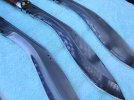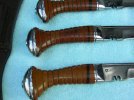- Joined
- Dec 28, 2003
- Messages
- 4,793
Some months ago Karel (Cosco) posted some pics of a beautiful 20" kukri made by his talented friend, Petr Dohnal of the Czech Republic. Several of us in correspondence were taken by the design, and wrote to Karel, asking him to communicate with Petr on our behalf. We wrote to several forumites about going in with us on a group buy, but after some trial and error ended up with a good working group of Aardvark (Joe), Sogguy (Dick), and myself.
It took many months and a lot of work on both Petr's and Karel's parts, but here is the result. These turned out better than we had hoped.
The knives weigh an average of 53 oz., which is heavy for a 20" knife. I have a 20" Samsher that is 40 oz., and a couple of Junge's that average 33. But the knives give an impression of strength and solidarity that has to be experienced to really be understood. The handles are a synthetic material called pertinax, which is very striking and they make the knives feel lighter than they are and balance very nicely. The sheaths are perfectly done in very thick leather.
The "3 Sisters" as Petr calls them range in weight from 52.7 oz. to 53.4, with one at 53.1. Just a 20 gram variance. Petr was incredibly consistent. Each knife has 3 holes drilled in the spine, with #1 having the first hole filled with brass and the last two empty, #2 the second hole, etc. Just a glance tells you that this is a "1 of 3" knife. The handles are banded in the order in which they were made, with #2 having a single black band as it was the first made. Petr probably should have just filled the first hole instead of the second on this, but he was just showing us the idea.
Each sheath is marked in a similar fashion, with 1, 2 or 3 indentation holes in each frog face, and range in weight from 13.3 oz. to 15.1 oz. Two of the knives are 20.50", and one is 20.25". Likewise, two of the handles are 5.75" and one is 5 7/8's or 5.875. That is measured from the front of the bolster to the end of the last pertinax ring. Spine widths on all 3 are .380", all the way down from the bolster to approx. 1.25" from the tip. Not having that distal taper and keeping the width constant is what gives them both their extra weight and unique feel.
We discussed differential hardening, and then decided to go with the blades fully hardened on Petr's recommendation, as he is using modern steels. He surprised us however by not only differentially hardening them, but then etching each to reveal a beautiful temper line.
Here are a few pics. This is one of those projects that turned out very well, and it was a pleasure doing this deal with two great forumites like Joe and Dick. :thumbup:
Norm




It took many months and a lot of work on both Petr's and Karel's parts, but here is the result. These turned out better than we had hoped.
The knives weigh an average of 53 oz., which is heavy for a 20" knife. I have a 20" Samsher that is 40 oz., and a couple of Junge's that average 33. But the knives give an impression of strength and solidarity that has to be experienced to really be understood. The handles are a synthetic material called pertinax, which is very striking and they make the knives feel lighter than they are and balance very nicely. The sheaths are perfectly done in very thick leather.
The "3 Sisters" as Petr calls them range in weight from 52.7 oz. to 53.4, with one at 53.1. Just a 20 gram variance. Petr was incredibly consistent. Each knife has 3 holes drilled in the spine, with #1 having the first hole filled with brass and the last two empty, #2 the second hole, etc. Just a glance tells you that this is a "1 of 3" knife. The handles are banded in the order in which they were made, with #2 having a single black band as it was the first made. Petr probably should have just filled the first hole instead of the second on this, but he was just showing us the idea.
Each sheath is marked in a similar fashion, with 1, 2 or 3 indentation holes in each frog face, and range in weight from 13.3 oz. to 15.1 oz. Two of the knives are 20.50", and one is 20.25". Likewise, two of the handles are 5.75" and one is 5 7/8's or 5.875. That is measured from the front of the bolster to the end of the last pertinax ring. Spine widths on all 3 are .380", all the way down from the bolster to approx. 1.25" from the tip. Not having that distal taper and keeping the width constant is what gives them both their extra weight and unique feel.
We discussed differential hardening, and then decided to go with the blades fully hardened on Petr's recommendation, as he is using modern steels. He surprised us however by not only differentially hardening them, but then etching each to reveal a beautiful temper line.
Here are a few pics. This is one of those projects that turned out very well, and it was a pleasure doing this deal with two great forumites like Joe and Dick. :thumbup:
Norm









